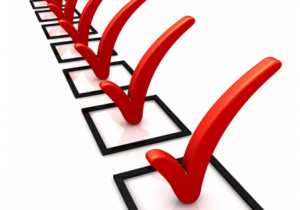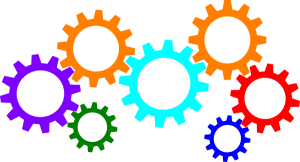How Effective Is Your Collaboration?
 When your team works with other departments on a project, how would you rate your collaboration efforts? Is there an open line of communication and a real effort to identify issues and solve them? Or are you just “getting along” and that’s about it. Collaboration across departments or organizations is about more than just “cooperating” with other teams. It’s vital to develop a shared vision, cultivate mutual respect and have an understanding of each other’s roles.
When your team works with other departments on a project, how would you rate your collaboration efforts? Is there an open line of communication and a real effort to identify issues and solve them? Or are you just “getting along” and that’s about it. Collaboration across departments or organizations is about more than just “cooperating” with other teams. It’s vital to develop a shared vision, cultivate mutual respect and have an understanding of each other’s roles.
Effective collaboration among teams has a number of benefits, including:
- Helps to build trust and strengthen relationships within teams and across departments.
- Leads to decisions that benefit both the departments and the entire organization.
- Promotes learning and communication through the information exchange.
- Encourages individuals and teams to work together to identify concerns and come up with proactive solutions.
On the other hand, there are a number of issues that can creep up when collaborative efforts between departments are not a priority or break down all together. A few of the biggest offenders include:
- Inability to consider other perspectives: Team members can become so focused on their own job and their own team that they don’t take into account the different needs of other departments with different functions. You can overcome this challenge by having workers spend more time learning and understanding the role of other teams within the organization, perhaps through job shadowing or training opportunities.
- Ineffective meetings: Meetings are an important tool for communication, but if they’re not run properly, they can be a big waste of time. When it comes to meetings, carefully consider the objectives, draft a clear agenda and have a plan in place to follow up on actions determined at the meeting. Make sure someone is in charge of the meeting who can keep it on time and stop it from getting sidetracked. For cross departmental collaboration to be effective, you need to ensure you have the right teams and the right team members in attendance.
- Lack of clear direction: This is another pitfall of poor communication and one that can lead to confusion, frustration and resentment. When it comes to cross departmental collaboration, define roles and responsibilities from the beginning and make sure they’re communicated clearly. It’s the team leaders’ responsibility to address questions and concerns and check in regularly to make sure team members continue to understand what they’re contributing to the project.
When organizations embark on projects without the proper consultation and collaboration between departments, it can lead to confusion, wasted time and resources, lost productivity or, at the very worst, a failed outcome. Working with a coach, like Leah M Joppy and Associates, can make sure you get started on the right path from the very beginning. We’ll help you navigate every step of the process, including how to build an effective communication plan to defining team roles and so much more.
Coaching is a powerful tool for driving collaboration and improving overall team performance. If you’re interested in boosting your collaboration efforts when working with other departments or organizations, contact us at 301-670-0051 or email us at leah@lmja.com to learn more.
Guidelines Designed To Help Your Organization Enhance Collaboration
 When it comes to collaborating with your own team, it can often seem like a no-brainer. You know everyone’s role and communication style, your meetings are fairly predictable and everything seems like it’s just humming along. But when you add another department or organization into the mix, it can really throw you for a loop. The dynamics are different, you don’t know everyone’s work style and communication can seem like a struggle. It can test both your team members and your leadership skills. However, if you build the foundation for strong cross department collaboration at the beginning of a project, it can make all the difference.
When it comes to collaborating with your own team, it can often seem like a no-brainer. You know everyone’s role and communication style, your meetings are fairly predictable and everything seems like it’s just humming along. But when you add another department or organization into the mix, it can really throw you for a loop. The dynamics are different, you don’t know everyone’s work style and communication can seem like a struggle. It can test both your team members and your leadership skills. However, if you build the foundation for strong cross department collaboration at the beginning of a project, it can make all the difference.
In our last article, we looked at the benefits of effective collaboration among departments, as well as the biggest offenders that lead to communication breakdown. What are some ways to enhance collaboration and avoid any pitfalls? Here’s a look at the top 6:
- Make sure everyone understands the overall objective and their role in it: We touched on this in our last article. If team members don’t understand their role and the common goal they’re working towards, it can really derail a project. Clear communication from the top is so important and it starts with strong leadership and transparency.
- Encourage consistent communication and feedback: Communication comes from the top. Leaders must create clear systems to make this happen and build a culture where team members feel comfortable providing feedback.
- Create a culture of collaboration and community: Casual get-togethers and other team-building opportunities are an important part of the collaboration process. More and more teams and departments are working remotely or on a hybrid schedule, adding another layer of challenges. Leading teams that are both remote and in-person work best when remote workers are encouraged to see and interact with the larger department teams.
- Get to know the way other departments work: Team members can’t collaborate effectively with other departments if they don’t understand what they do and their work style. Make sure your team members aren’t working in a bubble and have opportunities to job shadow if needed, get involved in other departments’ processes, etc.
- Share technology and information: Make sure each team has access to the same types of data, people, tools, etc. This keeps the lines of communication open and makes it easy for teams to approach one another if they have access to the same information.
- Celebrate successes: Taking time out to recognize team members’ contributions goes a long way towards building morale. And it doesn’t have to be at the end of the project. Celebrating milestones throughout the process is a great way to keep everyone motivated.
Collaborating across departments or organizations can seem like an uphill battle, but with the right coach by your side, it doesn’t have to be. Leah M Joppy and Associates can work with you to improve your collaboration efforts and ensure that there’s transparent communication, efficient processes and strong leadership at the helm. When collaborative efforts are working effectively, team members feel that their voice is valued, they’re more engaged, more receptive to ideas and more likely to do their best work. And who doesn’t want that?
Are you ready to learn more? Call us at 301-670-0051 or email us at leah@lmja.com.
When A Leader Leaves The Organization
 We’ve probably all experienced the stress of a key leader or team member leaving their position, whether it’s a sudden departure or an impending retirement. It can cause uncertainty within an organization and can really rock the boat. Team members have questions about the future and how changes will affect them and their jobs. And there’s the added challenge of finding the right person to fill a vacant position with the required skills and expertise. What if there was a way to make this type of situation easier to handle? It’s called succession planning and it’s a vital, yet often overlooked, tool in helping your organization run smoothly.
We’ve probably all experienced the stress of a key leader or team member leaving their position, whether it’s a sudden departure or an impending retirement. It can cause uncertainty within an organization and can really rock the boat. Team members have questions about the future and how changes will affect them and their jobs. And there’s the added challenge of finding the right person to fill a vacant position with the required skills and expertise. What if there was a way to make this type of situation easier to handle? It’s called succession planning and it’s a vital, yet often overlooked, tool in helping your organization run smoothly.
What is succession planning? It’s the process of identifying critical positions within your organization and developing an action plan for team members to be ready to fill those positions should they become available. Think of it as an insurance plan that you have the right people in the right jobs when you need them. However, it’s not a one and done kind of task. An effective succession plan should be reevaluated and updated each year or when changes dictate.
There are so many benefits to succession planning, yet many organizations don’t take the time and care required to build an effective plan. However, putting in the effort reaps so many rewards, including the following:
- Helps your organization plan for the future: Change can happen fast and so many organizations are caught off guard when a key team member leaves. With succession planning, leaders continually think about how certain events can affect their department as a whole and it makes them more resilient in the face of unexpected events.
- Assists with knowledge transfer: When a long-time employee retires or leaves for another position, they take their knowledge with them. Succession planning helps to stop this drain on organizations by having future candidates who are ready to take the reins. It opens up the opportunity for mentoring, coaching and education on what it takes to be successful in a future role.
- Promotes training and development: Once your company has identified team members that are interested in moving into senior positions, you can identify any competency gaps and begin preparing them for their eventual roles. This may come in the form of coaching, mentoring, job shadowing or a gradual increase in more advanced responsibilities. Some positions may require certifications or continuing education.
- Helps with long-term talent planning and employee retention: Succession planning improves retention of your top employees by offering them clear opportunities for growth. By planning longer-term, organizations can reduce their reliance on external recruitment and have a pool of experienced employees in-house.
Changes in your team are inevitable. You may not always be able to predict an employee’s departure, but with effective succession planning, you can help achieve continuity and lessen the impact on your organization. Does your department have a succession plan in place? If so, when’s the last time it was updated? Leah M Joppy and Associates can work with your organization to develop an effective succession plan or review your current plan and make suggestions for improvements. We get to know your department and unique needs and walk you through every step of the process (you’ll see a few examples in our next article).
Succession plans are easy to let fall through the cracks, but don’t be caught off-guard if you lose a key member of your team. Contact us at 301-670-0051 or email us at leah@lmja.com to learn more.
Tips For Successful Succession Planning
 An aging workforce, shrinking talent pool and intensified competition for the right team members put so many organizations under increasing pressure. The benefits of succession planning have never been more apparent, yet few organizations have a plan at all, even for senior leadership positions. With the right plan in place, you can rest a little easier knowing that you’re prepared for inevitable personnel changes and won’t be caught off guard.
An aging workforce, shrinking talent pool and intensified competition for the right team members put so many organizations under increasing pressure. The benefits of succession planning have never been more apparent, yet few organizations have a plan at all, even for senior leadership positions. With the right plan in place, you can rest a little easier knowing that you’re prepared for inevitable personnel changes and won’t be caught off guard.
How can your organization get started with succession planning? Here are a few tips for kickstarting an effective plan:
- Identify potential roles to plan for: The first step is to identify the critical positions within your organization. Sometimes these positions are leadership roles or they’re mid-level. You should identify roles where the operation, strategy and decision-making of your organization would be dramatically affected if they were to be suddenly empty.
- Define succession criteria: Criteria includes the skillset, experience and training required for potential successors. Does the role need someone with specific technical expertise? Perhaps you need successors with strong leadership skills or the ability and willingness to develop those skills? These criteria act as your benchmark for evaluating the readiness of candidates to fill your roles.
- Pinpoint succession candidates: Think about which team members could potentially step into the identified positions. Ask yourself: If we were to hire for a position internally, who could possibly step into the role? You want to carefully evaluate employees’ performance, potential and readiness to take on higher-level responsibilities.
- Step up professional development efforts: Now that you’ve identified your talent pool, it’s time to focus on the training to get them to where they need to be. This typically involves creating a personalized development plan for potential successors to enhance their skills and knowledge required for future leadership roles.
- Develop a knowledge transfer process: This opens up opportunities for mentoring and coaching for successors and ensures that specialized knowledge and skills don’t leave when a team member walks out the door. Experienced leaders can guide and support successors in their professional growth, while sharing their knowledge and experiences.
- Review and monitor your plan: Regularly monitoring the progress of the succession plan is vital to its success. This typically involves tracking the development and performance of potential successors, evaluating their readiness for advancement and then making any adjustments to the plan.
- Continually update your plan over time: As we mentioned before, succession planning is not a one and done process. It requires review at least yearly to analyze any areas that need adjustment.
Most of all, it’s vital to be proactive with a plan! Sometimes, you’ll know well in advance if a hard-to-replace team member is going to leave. But other times, you’ll be caught off-guard by a sudden employee departure. That’s why you need a plan now. Leah M Joppy and Associates can help you every step of the way with your succession planning. Drafting a succession plan can feel like a daunting task, but with the right coach working with you through the process, it doesn’t have to be. And the result means you won’t have to deal with the upheaval that can come with personnel changes.
Ready to learn more? Call us at 301-670-0051 or email us at leah@lmja.com.
Overworked? Burned Out?
 Last month, the website FinanceBuzz released a study of the most overworked cities in the U.S. In the study, researchers looked at metrics such as:
Last month, the website FinanceBuzz released a study of the most overworked cities in the U.S. In the study, researchers looked at metrics such as:
- average number of hours worked per week,
- average commute time and
- percentage of workers who work 50+ weeks per year.
And the winner of the most overworked city is: Washington, D.C. If you’d like to take a closer look at the study and the methodology behind it, here’s a link.
We probably don’t need a study to tell us that the Washington region suffers from a severe case of “overwork.” So many of us feel like we’re doing the work of two or three people and juggling it all can seem like an impossible task. But very few people can keep going at a frantic pace and not experience some symptoms of overwork. A few of the most common symptoms are outlined below:
- Increased stress levels and physical symptoms: People may notice fatigue, headaches or gastrointestinal issues.
- Difficulty sleeping: Sleep behaviors may be disturbed, reduced or increased.
- Decreased productivity: When workloads increase, employees may struggle to keep up, resulting in missed deadlines and making more mistakes.
- Procrastination: Some employees may resort to avoidance and procrastination as a way to deal with overwhelm.
- Increased absenteeism: Increased workloads can cause employees to take more sick leave to deal with stress.
- Decreased job satisfaction: When workers feel overwhelmed and overworked, they may lose motivation and become disillusioned with their jobs. This can often lead to higher rates of turnover, particularly in a competitive job market.
Although they’re similar and often used interchangeably, overwork and burnout are not the same. Overwork refers to the act of working too hard or too much. The term “burnout” was first used in 1974 by German-American psychologist Herbert Freudenberger, who defined it as “the physical or mental collapse caused by overwork or stress.” The key is to identify any symptoms of overwork you may be experiencing (the earlier, the better!), so you can prevent burnout.
Prolonged periods of overwork can begin to take a toll on our mental and physical health, as well as personal relationships. When we overwork and fail to prioritize our own needs and self-care, we don’t give our brain or body what it needs to recuperate. In our next article, we’ll take a look at a few ways to handle increasing workloads. If you notice that your workload is starting to negatively impact your life, working with a coach, like Leah M Joppy and Associates, can be incredibly beneficial. We can help you achieve the balance you’ve been striving for, both professionally and personally, before your day-to-day stressors lead to burnout. Contact us at 301-670-0051 or email us at leah@lmja.com to learn more.
Handling Increasing Workloads
 Steadily increasing workloads may seem like a harsh reality in today’s workplace. Technology ensures that we’re available 24/7. Working from home can make it hard to unplug and create a work/home balance. Falling into the routine of overwork is easy, but getting yourself out of it can feel like an uphill task. However, it’s not impossible and your mental and physical health may depend on it.
Steadily increasing workloads may seem like a harsh reality in today’s workplace. Technology ensures that we’re available 24/7. Working from home can make it hard to unplug and create a work/home balance. Falling into the routine of overwork is easy, but getting yourself out of it can feel like an uphill task. However, it’s not impossible and your mental and physical health may depend on it.
No one is equipped to go at lightning speed without suffering some mental and/or physical repercussions, whether it’s right now or down the road. We outlined a few symptoms of overwork in our last article. Perhaps you’re dealing with one or more, but feel helpless and wonder if there’s anything you can do about it. Here are 6 suggestions to keep in mind:
- Minimize distractions and identify time-wasters: Suggestions include checking e-mail only a few times a day, staying off social media, using earphones if you work in a loud environment and setting clear boundaries if you work from home with family members in the house.
- Make lists and establish priorities: Write down everything you need to accomplish in a given day and then assign each task a priority. Project managers often use the 4Ds of time management: Do, Delegate, Delay and Drop. Checking off tasks as you complete them can also give a sense of accomplishment. It’s a small, but powerful step!
- Delegate where you can: So many us get in the mindset of, “Oh, it’ll be quicker and easier if I just do it myself.” This is particularly true of new managers. However, if you’re in a position to delegate tasks, do it! There is a limit to what one person can do.
- Sit down and talk with your manager: If you feel comfortable, enlightening your manager about your situation can help you both come up with strategies. But don’t just walk into their office without a plan. Ask yourself if your current workload is acceptable for your role and job description. Come in with your list of priorities to share. And propose a solution you can both discuss.
- Pursue hobbies outside of work: A hobby not only brings fulfillment, but also makes your brain think in different way and takes your mind off your job. If you work remotely, try to pursue a hobby that gets you out of the house.
- Prioritize wellness into your routine: We’re talking exercise, breathing techniques, meditation, anything that helps calm and recharge you.
And remember, you don’t have to go through this alone. Working with a coach, like Leah M Joppy and Associates, can help you chart a clearer path forward. We’ll discuss your unique situation, strategies for dealing with your increasing workload and help you establish possible solutions and clear boundaries. The key is to get ahead of your workload situation before it leads to burnout.
Ready to learn more? Call us at 301-670-0051 or email us at leah@lmja.com.
When It’s Challenging To Recruit, Consider The Assets Of The Department
 It’s no secret that it’s getting more and more challenging to recruit, hire and retain employees. You may wonder how you can compete, particularly when other organizations may be willing to offer higher compensation. However, salary isn’t the only factor that job seekers look at when searching for a new position. So many other variables come into play, like a department’s culture, flexibility and an emphasis on well-being. The key to making your open positions stand out is to tell your unique story in a clear and effective way through a strong employee value proposition.
It’s no secret that it’s getting more and more challenging to recruit, hire and retain employees. You may wonder how you can compete, particularly when other organizations may be willing to offer higher compensation. However, salary isn’t the only factor that job seekers look at when searching for a new position. So many other variables come into play, like a department’s culture, flexibility and an emphasis on well-being. The key to making your open positions stand out is to tell your unique story in a clear and effective way through a strong employee value proposition.
What is an employee value proposition (EVP)? Simply put, an EVP communicates the value an employer provides to its employees. Some of these assets may be beyond your control, but others can be emphasized by good leadership and professionalism. The most compelling EVPs include tangible assets, like benefits packages, and intangible values such as professional growth opportunities. The more benefits of working for your organization that you provide, the stronger your EVP is when hiring new team members.
No matter the state of the job market, an effective EVP is a vital tool for talent acquisition. It encompasses the assets you offer as an employer to attract new talent and retain your best employees. Here’s a sample of three sections every good EVP should have:
- Benefits and Perks: According to a Glassdoor survey, 80% of employees value stronger benefits packages over pay increases. Employee benefits are an important part of a good EVP and you should be clear about what you offer. Here’s a sample of what you can include:
- Health insurance policy
- Childcare
- Sick leave
- Parental leave
- Paid vacation
- Retirement plan
- Career Development Opportunities: Providing employees with the opportunity to learn new skills shows them you’re invested in their success. Career development options could include the following:
- On-site training opportunities. We can help reinforce training for your group!
- Tuition assistance.
- Coaching opportunities. LMJA also offers coaching to groups or individuals.
- Certification programs.
- Organizational Culture: Unlike the last two examples, an organization’s culture isn’t tangible, but that doesn’t make it any less important. In fact, cultural fit is key when attracting and retaining employees. LMJA and Associates is particularly helpful in developing and maintaining an attractive culture. Here are some ways to showcase your organization’s culture:
- Hybrid and remote work opportunities.
- Flexible hours. Can a new employee work around hours that fit his/her schedule more easily?
- Teamwork values. How effective are your teams? True teamwork increases work satisfaction. We can help with quality team management.
- Diversity and inclusion statements. The value of diversity has increased in the last few years. LMJA can help here too.
- Management style. LMJA has several courses aimed at building exceptional leadership skills.
- Well-being perks.
With available jobs seemingly outpacing the number of candidates, it’s more important than ever for organizations to attract and retain talent. That’s why it’s vital for organizations to develop a compelling EVP and then effectively communicate it both internally and externally. It can seem like a daunting task, but Leah M Joppy and Associates can help you create an EVP and add various strengths throughout the department. Through these efforts, you have the ability to tell your organization’s unique story and why potential new hires should work for you! Contact us at 301-670-0051 or email us at leah@lmja.com to learn more and get started.
How Your Organization Can Attract Millennial and Gen Z Employees
 Finding the right employees can be tough, but keeping them can be even tougher. In 2022, 46.2 million workers voluntarily quit their jobs, becoming what’s now known as The Great Resignation. And it’s estimated that 46% of the American workforce wants to switch jobs in 2023, making employee retention a key concern. Now more than ever, organizations need to come up with fresh approaches to retain their current workers. This is especially true of Millennial and Gen Z employees.
Finding the right employees can be tough, but keeping them can be even tougher. In 2022, 46.2 million workers voluntarily quit their jobs, becoming what’s now known as The Great Resignation. And it’s estimated that 46% of the American workforce wants to switch jobs in 2023, making employee retention a key concern. Now more than ever, organizations need to come up with fresh approaches to retain their current workers. This is especially true of Millennial and Gen Z employees.
Let’s take a look at these two groups. Millennials were born between 1981 and 1996 while Gen Z refers to those born between 1997 and 2012. Between the two of them, they make up almost 50% of the workforce today. Gen-Z alone is expected to form 27% of the workforce in the next two years. Both Millennials and Gen Z have a reputation for job hopping and lacking “company loyalty”. However, if organizations make an effort to understand the needs and wants of these two groups and grant them the opportunities to grow and thrive, this reputation isn’t always true.
Your recruitment strategies may have helped you acquire a new crop of employees, but if they are not rewarded appropriately with career opportunities, development and other incentives, there is a larger risk of them leaving. What are some of the top things that Millennials and Gen Z look for in an employer? Here’s a glimpse at 5 of them:
- Offer them flexibility and work-life balance: Some may bristle at the work-from-home or hybrid model, but it’s here to stay. Gen Z and millennial employees value flexible work places and working practices and are interested in jobs that will be adaptable to their lifestyle.
- Place an emphasis on their well-being: Millennials and Gen Z want to work for organizations who take care of them and their health as individuals. And it’s not just about physical well-being, but mental health as well.
- Provide them with strong, transparent managers: Management really matters! Grant these two groups more autonomy and less micromanagement, communicate openly and seek their input and ideas.
- Invest in their growth: Gallup found that 87% of millennials rate development opportunities as important to them in a job and LinkedIn found that 76% of Gen Z say learning is key to their success.
- Provide them with mentors: A study by CNBC found that 90% of employees who have assigned mentors say they are happy in their jobs. And greater employee satisfaction leads to better retention!
In today’s multigenerational workforce, organizations can no longer rely on a one-size-fits-all approach to retaining and motivating employees. The most successful organizations truly understand employees’ expectations in the workplace. Leah M Joppy and Associates can work with your organization to build an effective employee retention strategy and help you create programs, systems and communication styles that they meet different employee needs, whatever generation they are from.
Ready to learn more? Call us at 301-670-0051 or email us at leah@lmja.com.
The Composition Of An Effective Team
 Have you ever been a member of (or led) an exceptional workplace team? What are some of the positives that come to mind? Was it engaging and collaborative? Did you meet and exceed your goals? Did everyone feel valued and appreciated? It’s a great feeling, isn’t it? Yet all too often, teams fall short of being as effective as they can be and reaching their potential. The impacts are felt by employees, leaders and organizations as a whole.
Have you ever been a member of (or led) an exceptional workplace team? What are some of the positives that come to mind? Was it engaging and collaborative? Did you meet and exceed your goals? Did everyone feel valued and appreciated? It’s a great feeling, isn’t it? Yet all too often, teams fall short of being as effective as they can be and reaching their potential. The impacts are felt by employees, leaders and organizations as a whole.
So, what exactly do we mean by an “effective team”? It’s the capacity of a group of people, usually with complementary skills, to work together to achieve its goals and objectives. And it’s one of the biggest indicators of an organization’s success. According to Gallup, teams that rank in the top 20% for connectedness see 41% less absenteeism, 59% less employee turnover and a 66% increase in employee wellness. With numbers like that, it’s hard to argue that high performing teams are an integral part of your organization and worth the investment to develop and nurture.
Teams are as varied and unique as the people within them, but when it comes to effective, high performing teams, there are some common characteristics:
- Clear, achievable goals
- A shared commitment
- Clarity of roles and responsibilities
- A sense of purpose
- Clear processes and procedures
- Joint accountability
- A result-oriented approach
Effective teams also tend to show greater resilience by working through challenges and bouncing back from adversity. They also tend to maintain vitality and the energy needed for future success.
It’s no surprise that an effective team is only as strong as the person leading it. In our next article, we’ll get into more about what it takes to lead a high-performance team. The right leadership enhances a team’s success, but far too often, people are placed in leadership roles without any proper leadership development training. It’s vital for leaders to take advantage of every opportunity to enhance their leadership skills. However, it’s also vital for organizations to provide these opportunities in the first place. Working with a coach like Leah M Joppy and Associates can help your leaders identify their strengths and weaknesses and develop the skills needed to build effective teams (strong communication, building trust and resiliency, defining roles and responsibilities and so much more).
Do you want to lead a high performing team, but don’t know where to start? Contact Leah M Joppy and Associates at 301-670-0051 or email us at leah@lmja.com to learn more and get started.
Top Five Suggestions For Leading An Effective Team
 Today’s leaders often feel like they’re in a never-ending game of tug-of-war. Between dealing with day-to-day obstacles, managing projects and team members, it can be overwhelming. The “people” component is certainly the most integral to an organization and can prove to be the most challenging. Building a high-performing team is more than just putting together a group of talented people with the right skills. It requires careful development of each member’s unique talents and characteristics.
Today’s leaders often feel like they’re in a never-ending game of tug-of-war. Between dealing with day-to-day obstacles, managing projects and team members, it can be overwhelming. The “people” component is certainly the most integral to an organization and can prove to be the most challenging. Building a high-performing team is more than just putting together a group of talented people with the right skills. It requires careful development of each member’s unique talents and characteristics.
There is so much strong leaders can do to build effective, high-performing teams. Here’s a look at the top five suggestions. But remember, it’s a marathon and not a sprint. It’s a continuous process and not a “one and done” task:
- Establish meaning and purpose: It’s a leader’s job to help employees and teams find meaning in their work. To increase productivity and motivation, have discussions about the “why” of your team’s tasks. Team members who are passionate and motivated help drive team effectiveness because they understand how their work contributes to the organization’s overall objectives.
- Define roles and responsibilities: Leaders must ensure that everyone on the team knows exactly what is expected of them. It reduces confusion and conflict and allows teams to work more efficiently. Role clarity also enables leaders to hold team members accountable for their performance and identify areas where someone may struggle.
- Communicate effectively: Effective communication and effective leadership are definitely intertwined and it can make, or break, a team. As a leader, it’s vital to: practice active listening and allow people to give constructive feedback without fear of repercussions; ask questions and don’t be defensive; have an open-door policy; follow through with actions.
- Focus on building relationships: Building relationships helps to create (or reinforce) an organization’s values and culture. Once leaders and team members genuinely trust and respect each other, regular, open dialogue about individual and team performance increases team effectiveness.
- Provide productive, specific and timely feedback: Feedback is critical to improving performance, but how you deliver it can make a big difference. Productive feedback enables team members to see their successes and missteps and grow from the experience.
To build high-performing teams, organizations must cultivate high-performing leaders. People skills typically account for 80 percent of success in a leadership role. Yet many people are promoted into leadership because of their technical capabilities, without mastering the skills of managing and motivating others. Without these basic skills, leaders at every level can struggle with building high-performing teams. Leah M Joppy and Associates understands the challenges that accompany leadership roles and knows the proven techniques for building strong leaders who can build motivated, productive teams.
Ready to learn more? Call us at 301-670-0051 or email us at leah@lmja.com.